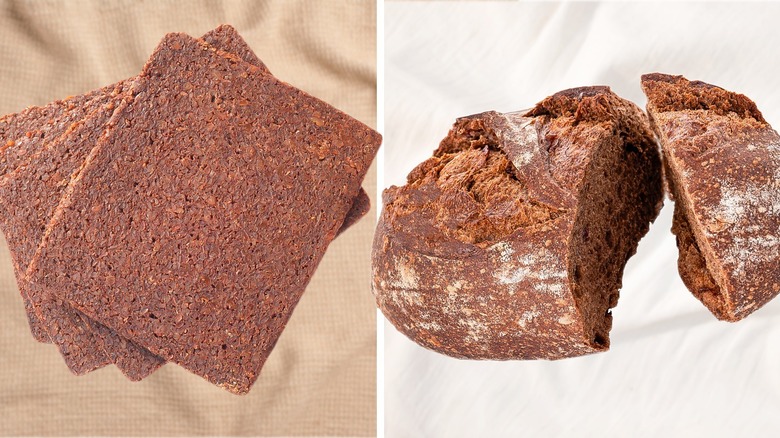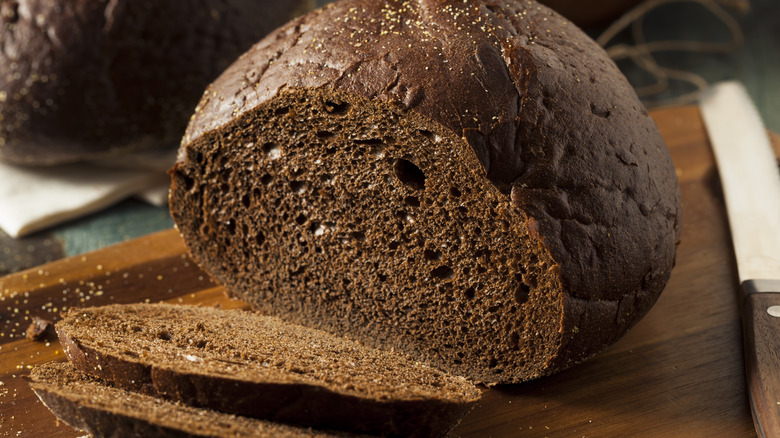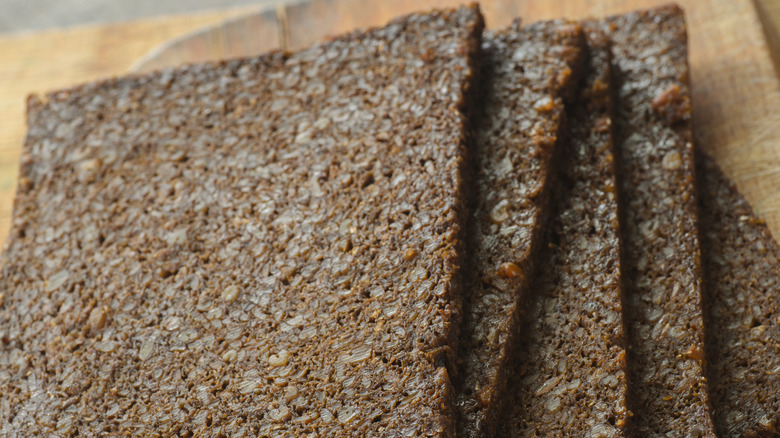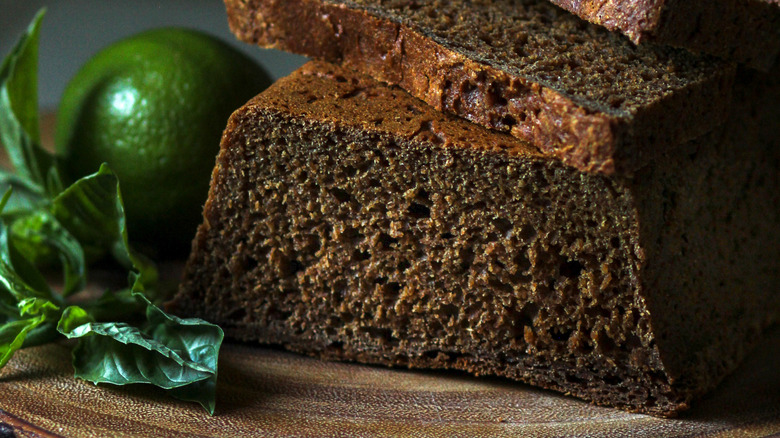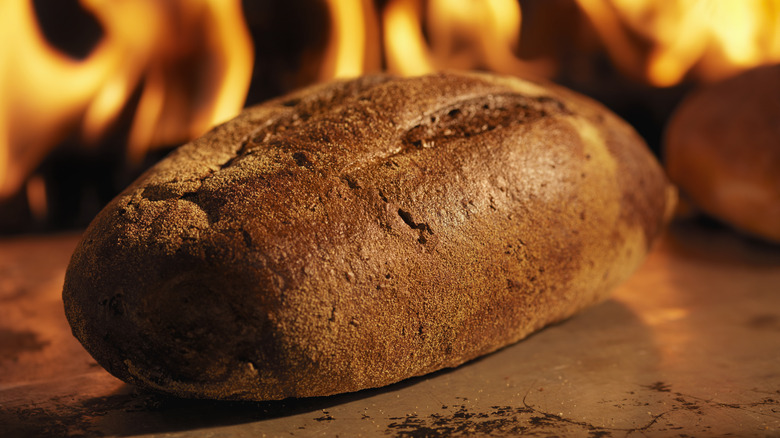The Difference Between American And German Pumpernickel Bread
When it comes to rye bread, few varieties have the bold intrigue of pumpernickel. Its, ahem, hearty nature, especially post-eating, even inspired its humorous name — devil's flatulence — when translated from German. However, the taste and texture are far from a joke. Pumpernickel is a seriously delicious thick rich bread, perfect served with a variety of savory toppings, fillings, and side bites.
Yet just how dense, and rye-forward a loaf is depends on the regional style. In the U.S., pumpernickel is crafted into a more familiar rounded loaf. It contains an airier texture, has a crust, and offers additional flavors for an aromatic result. This deviates from the original German concoction, which uses only dark rye flour for a very dense bread. Both are delicious but are quite different. And unpacking their differences showcases how the tasty bread comes together. So, let's dive into the details of these two pumpernickel loaves.
What is American pumpernickel bread?
American pumpernickel bread has a brown to black color, with varying shades. Its exterior crust is thick, encasing a chewy interior. It easily separates into crumbs and has a pleasantly sweet flavor. The use of cocoa and molasses is the usual combination that brings the rich sweetness, and while these components recreate the color of European pumpernickel bread they invoke a unique flavor palate.
The North American version employs a mixture of flours, typically both wheat and rye. For the starter, it's a dry yeast, which largely contributes to its bread-like texture. And with the use of various flour bases, the American loaf takes on a large variety of forms. Some incorporate cornmeal, while others stick to a mixture of all-purpose and rye. To finish the exterior crust, the bread is usually coated with poppy seeds, while some blend in caraway seeds, crafting an interesting aromatic loaf. American pumpernickel makes for tasty sandwich bread and goes well with rich soups and thick spreads. Plus, it's pretty shelf-stable and will keep for three days.
What is German pumpernickel bread?
German pumpernickel is a thick, dark brown bread. It doesn't have a crust and, when baked properly, has an even distribution of moisture. The bread gets its bold character from a specific type of rye flour. Sometimes referred to as pumpernickel flour, this product offers a coarser texture due to the inclusion of more of the grains' external layers. And this flour bakes especially well with sourdough, which is the most common starter for the bread. German pumpernickel only relies on the rye for flavor, which lends it a distinctive earthy character with a touch of sweetness, countered with a mild sourness from the sourdough starter. The texture is hefty and chewy, with a noticeably thick nature.
German pumpernickel originated in regions where wheat is difficult to harvest. As a rare rye-only bread, it's very nourishing and rich in minerals. A slice contains around 125 calories and offers large servings of fiber, iron, and some proteins, according to Nutritional Value. As a result, it makes for an excellent hearty snack, pairing well with rich-flavored toppings such as cold cuts, smoked fish, and cheese.
German pumpernickel is denser than American
German pumpernickel's denser character arises due to the rye flour base matched with a specific baking process. Exclusively rye flour — which has a rough texture — is formed into a dough and set into rectangular, covered molds. The bread is baked for a longer time at a lower temperature than bread is normally baked at. The process not only retains more water content but also encourages caramelization, which lends the loaf a naturally dark color. In traditional bakeries, the loaf is finished by steaming, prolonging the cooking process to as long as 24 hours, and giving it a very moist and rich finished texture and taste.
Conversely, American pumpernickel follows a more traditional baking practice, combining wheat with active yeasts to attain a quick rise. The bread is heated to a higher temperature and without a mold, lending a puffed shape associated with a regular loaf of bread. And while the rye flour is still present, it's not such a predominant character. As a result, American pumpernickel still results in a delicious loaf, albeit more similar in consistency to other everyday types of bread.
German pumpernickel has a more dominant rye flavor
Boosted by its rye flour base, German pumpernickel contains only a few additional components for flavor. Even packaged examples are sparse in their ingredients — relying on flour and sourdough for their taste. Largely, this is due to coarse rye flour's bold palate, which has complex, earthy flavors. Plus, this type of flour is higher in natural sugar, although some recipes do add molasses for extra caramelization. The resulting loaf has a rye-forward flavor, which defines its unique character.
Conversely, in American pumpernickel, many colorings and flavorings are introduced to lend the bread color and flavor. The bitterness of coffee and cocoa powder are frequent go-tos, supplemented with molasses for sweetness. Expect a loaf with less of a hearty, grain-forward essence than the German variety and, instead, a slightly sweet and bitter bread open to varying flavor combinations. Nonetheless, both are tasty savory options, equally suitable for a hearty lunch.
